The week at a glance
- Fea's Petrels in Orkney and East Yorkshire
- Green Heron in Cornwall
- Solitary Sandpiper in Devon
- Sharp-tailed Sandpiper in Co Dublin
- Buff-bellied Pipit in Co Waterford
- Hermit Thrush on Outer Hebrides
- Grey-cheeked Thrush on Scilly
- Steppe Grey Shrike in Aberdeenshire
- House Crow and possible Collared Flycatcher in Co Cork
- Possible Wilson's Snipe in Dumfries & Galloway
With most of the scarce migrants passed through now, and with the first real winter weather, and snow, at the end of the week, things were starting to quieten down. However, there was still plenty of interest during the week.
There was an interesting run of records of Fea's Petrel, with one past North Ronaldsay (Orkney) during the late morning on 16th and then incredibly a second bird two and a quarter hours later past Flamborough Head (East Yorkshire), along with 95 Pomarine Skuas, 192 Sooty Shearwaters and 175 Little Gulls.
Some of the best birds remained in the southwest, though, with the first-winter Green Heron still showing well in the Lost Gardens of Heligan (Cornwall) all week, and the equally obliging juvenile Solitary Sandpiper at Seaton Marshes (Devon) to 15th.
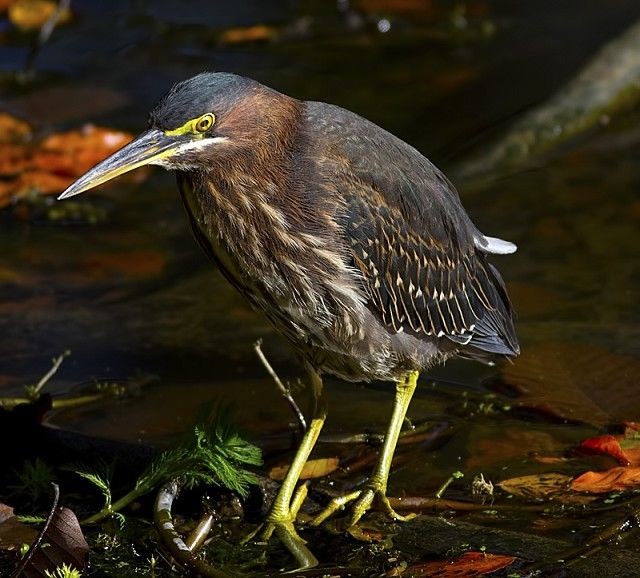
Green Heron, Heligan, Cornwall (Photo: Rob Cross)

Solitary Sandpiper, Seaton Marshes, Devon (Photo: Dave Hutton)
Ireland also continued to produce good birds, including a juvenile Sharp-tailed Sandpiper at Rogerstown estuary (Co Dublin) on 16th–17th. This is the fourth for Ireland, with previous records in Co Wexford (two) and Co Cork. There was yet another new Buff-bellied Pipit as well, on the beach at Clonea (Co Waterford) on 17th–19th.

Buff-bellied Pipit, Clonea, Waterford (Photo: Ronan McLaughlin)
There was continued Catharus interest this week, with a Hermit Thrush frequenting the football pitch at Castlebay, Barra (Outer Hebrides) on 14th–16th. This may well have been the same bird as at Brevig, but could equally be a new arrival. At the opposite end of the country, Scilly eventually caught up, with a Grey-cheeked Thrush at Middle Town, St Martin's on 19th, though this was barely twitchable.
A shrike found by the warden's eight-year-old daughter at Loch of Strathbeg (Aberdeenshire) on 14th turned out to be a Steppe Grey Shrike. It was very obliging at times and remained to 18th. This is the first mainland record for Scotland, with three records each of 'Southern Grey Shrike' on Shetland and Orkney.
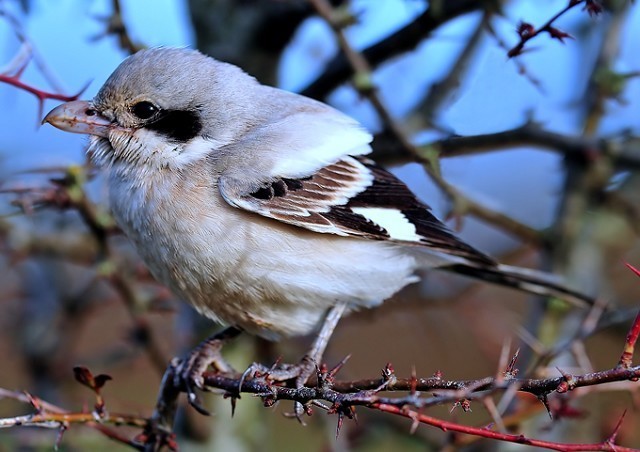
Steppe Grey Shrike, Loch of Strathbeg RSPB, Aberdeenshire (Photo: Alan Sinclair)
Elsewhere the House Crow remained at Cobh (Co Cork) to at least 19th but there were no reports of the Devon House Finch.
One of last week's possibles remained, in the form of a first-winter female Collared Flycatcher on Cape Clear (Co Cork) to 15th. In-hand measurements seemed to confirm the identification. One other possible was a late report of a Wilson's Snipe from the hide at Wigtown (Dumfries & Galloway) from 12th–15th.
There are always a few retrospective identifications as well, and it now seems like the mystery harrier photographed at Holme NOA (Norfolk) on 10th was actually a Pallid Harrier, and watch this space for details of a possible report of another Empidonax flycatcher in south Wales.
The Ross's Goose in the northwest remained, seen with 14,000 Barnacle Geese at Rockcliffe Marsh (Cumbria) on 16th, with a blue-morph Snow Goose there on 16th–19th. Other Snow Geese were at Kintraw (Argyll) again to 15th and West Burra (Shetland) on 19th, with three adults and three juveniles at East Chevington (Northumberland) on 15th. Perhaps of more interest was the arrival at Loch Gruinart, Islay (Argyll) of enough Canada Geese to keep many a taxonomist happy. Three Richardson's Canada Geese were there on 16th, joined the next day by two Lesser Canada Geese (race parvipes) and a probable Cackling Canada Goose. The only other geese of interest were Black Brants at Ferrybridge (Dorset) on 17th–19th and Freiston Shore (Lincolnshire) on 18th.
The two resident Ferruginous Ducks were at Chew Valley Lake (Somerset), with another drake at Pugney's Country Park (West Yorkshire) on 19th–20th and the female at Lackford Lakes (Suffolk) again to 18th. The drake Ring-necked Ducks remained at Chew Valley Lake all week and at Kirkby on Bain Gravel Pits (Lincolnshire) to 17th, with another drake at Foxcote Reservoir (Buckinghamshire) on 20th. The juvenile Blue-winged Teal was still at Shannon Airport Lagoon (Co Clare) to 16th with the only other at Wigtown Harbour (Dumfries & Galloway) on 19th. The first Green-winged Teal of the autumn was at Kinneil Lagoon (Forth) on 14th–19th. There were also possible female American Wigeon at Long Eaton Gravel Pit (Derbyshire) on 15th and at Holme Pierrepont (Nottinghamshire) on 16th, though neither were confirmed.

Green-winged Teal, Kinneil Lagoon, Forth (Photo: Andrew Muirhead)
The drake Lesser Scaup remained at Draycote Water (Warwickshire) to 17th and the bird in Dumfries & Galloway moved to Loch Ryan on 16th. The drake Surf Scoter also remained in Inganess Bay (Orkney), reported on 17th in the company of 11 Velvet Scoter and 12 Slavonian Grebes.

Lesser Scaup, Loch Ryan, Dumfries & Galloway (Photo: Alyn Chambers)
Further south, the King Eider remained off the Suffolk coast between Minsmere and Dunwich Cliffs all week and may well have been the same bird seen drifting past Sheringham (Norfolk) on 15th and then north past Thorpeness (Suffolk) on 16th. Other drakes were again off North Ronaldsay (Orkney) and Burghead (Moray & Nairn) on 14th and one was off Fair Isle (Shetland) on 19th. The drake Northern Eider was again at Embo (Highland) on 16th.
This week saw the end of the SeaWatch SW daily recording at Gwennap Head (Cornwall), so records of certain seabirds will be much reduced now. Their last two days saw single-figure counts of Balearic Shearwaters, with the only other records being of five off Trevalga (Cornwall) on 15th and one past Tarbat Ness (Highland) on 19th — a very late bird for Scotland. There were also fewer records of Sooty Shearwater, though a few large counts, including 82 past North Ronaldsay (Orkney) in just one hour on 17th, did hint at the numbers still out at sea.
The only long-staying Glossy Ibis was on the Otter estuary (Devon) to 18th whilst the Co Tyrone bird was still near Ardboe on Lough Neagh on 15th. Other more transient birds were at Cresswell Pond (Northumberland) for 10 minutes on 15th, Matford Pools and nearby Exminster Marshes (Devon) on 17th–20th; the Spanish colour-ringed bird at Valley Lakes (Anglesey) had previously visited both the Otter estuary and Avonmouth. Lastly, and most unusually, three were reported over Euston Station (London) on 19th.

Glossy Ibis, Budleigh Salterton, Devon (Photo: Joe Stockwell)
It's interesting to think whether some birds do disappear or just go unreported for periods. A good example was the White Stork reported again from Wareham (Dorset) on 17th, almost two weeks after the previous report.
None of the long-staying Great White Egrets were reported during the week, but there were still plenty of reports, in Argyll, Cumbria, Lancashire, Northamptonshire, Lincolnshire, Norfolk, Suffolk, Hampshire, Dorset and Kent, with three at Ham Wall (Somerset) on 15th.

Great White Egret, Leighton Moss RSPB, Lancashire (Photo: Paul Hargreaves)
Various Cattle Egrets were reported with one still at Grainthorpe Haven and Donna Nook (Lincolnshire) to 20th and new birds at Poyston (Pembrokeshire) on 15th–20th, the National Wetlands Centre (Carmarthen) on 18th and Veryan (Cornwall) during late afternoon on 19th. Pembrokeshire's first Squacco Heron remained at Angle Bay all week, providing some great photo opportunities.
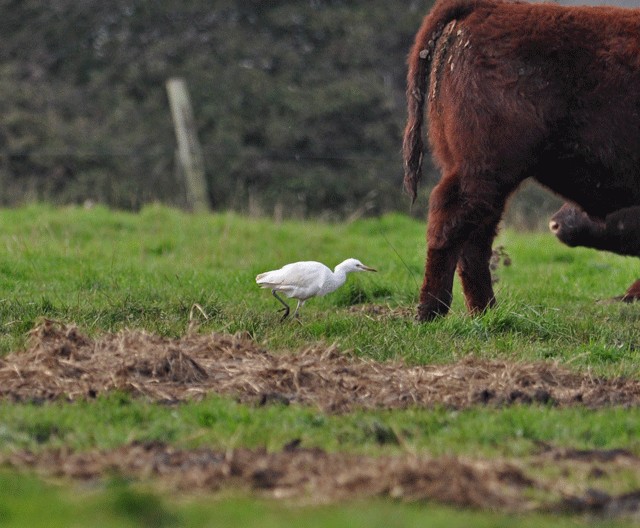
Cattle Egret, Donna Nook, Lincolnshire (Photo: Dave Goddard)
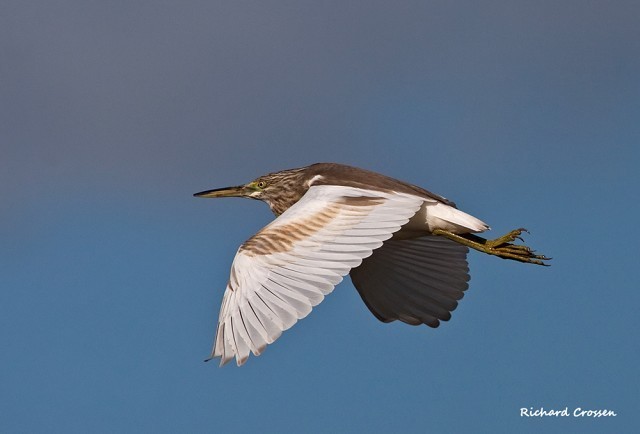
Squacco Heron, Angle Bay, Pembrokeshire (Photo: Richard Crossen)
On the raptor front, a Black Kite came in off the sea at Weston Cliff (Devon) on 19th and there was quite a good arrival of Rough-legged Buzzards along the east coast: up to 10 around East Yorkshire, seven in Lincolnshire and six in Suffolk. Norfolk recorded four, with two in Cleveland, two in Essex, two on Fair Isle (Shetland) on 16th and singles in Orkney, North Yorkshire and Cambridgeshire.

Rough-legged Buzzard, Donna Nook, Lincolnshire (Photo: Dave Goddard)
The Spotted Crake remained at Greylake RSPB (Somerset) to 19th and another was on Great Pool, Tresco (Scilly) on 18th.
Most of the Irish American Golden Plovers seem to have cleared out, with only one remaining, at Lissagriffin (Co Cork) to 19th, compared to six last week. The only remaining English bird was on St Mary's (Scilly) to 18th, with new arrivals at Baleshare, North Uist (Outer Hebrides) on 15th–16th, Dawlish Warren (Dorset) on 15th–19th and one roving between Cley, Langham and Cockthorpe (Norfolk) on 20th.
As ever, Buff-breasted Sandpipers matched this pattern, with the only records being the Cornish bird, which moved to Sennen on 17th–20th, and one at Ferrybridge (Dorset) briefly on 16th.
Following last week's 25 Pectoral Sandpipers, the only birds this week were at Welney (Norfolk) on 14th–20th, St Ouen's Pond (Jersey) on 14th–16th (though apparently present most of the month), Fail Loch (Ayr) on 14th–18th, Seaton Marshes (Devon) on 15th, Loch of Strathbeg (Aberdeenshire) on 16th, Gibraltar Point (Lincolnshire) on 16th–19th and Arlington Reservoir (East Sussex) on 20th.
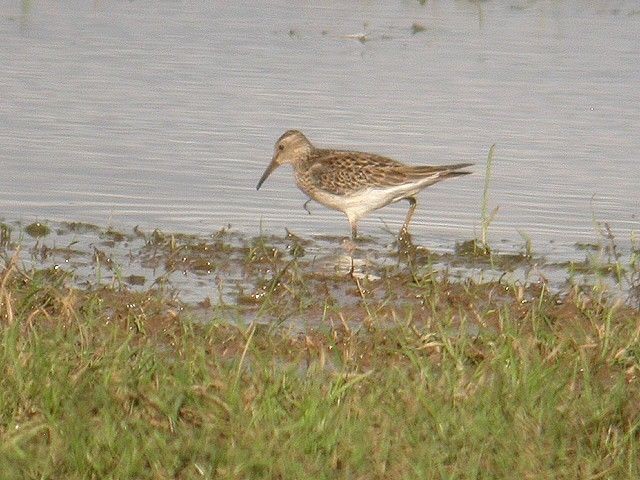
Pectoral Sandpiper, Fail Loch, Ayrshire (Photo: Brian Orr)
Reports of other Nearctic waders were few and far between. The Tyninghame (Lothian) Semipalmated Sandpiper remained to 15th with another at Ballylongford (Co Kerry) on 18th. The only White-rumped Sandpiper was at Kidwelly (Carmarthen) on 15th and the only Baird's Sandpiper remained at Holland Haven Country Park (Essex) all week. The Lesser Yellowlegs was on Port Meadow (Oxfordshire) all week with other briefer birds at Ballycotton (Co Wexford) on 15th and Marsh Lane NR (West Midlands) on 17th.
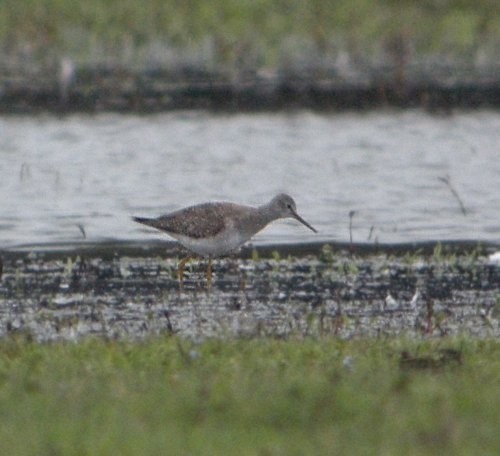
Lesser Yellowlegs, Port Meadow, Oxfordshire (Photo: Adam Hartley)
The Long-billed Dowitcher remained at The Cunnigar (Co Waterford) to 20th and the long-staying bird in the northwest may have been seen at Neumann's Flash (Cheshire) on 19th.

Long-billed Dowitcher, The Cunnigar, Waterford (Photo: Ronan McLaughlin)
There were no reports of Red-necked Phalaropes this week, and the only pelagic Grey Phalaropes were two past Kilcummin Head (Co Mayo) on 15th. Inland birds then roved between Cley, Salthouse and then Kelling (Norfolk) on 16th–20th, one remained at Sandy Water Park (Carmarthen) to 16th, and a new bird was at Covenham Reservoir (Lincolnshire) on 17th. There was only one record of Wilson's Phalarope, at Grove Ferry (Kent) on 17th–19th.

Grey Phalarope, Covenham Reservoir, Lincolnshire (Photo: Dean Eades)

Wilson's Phalarope, Grove Ferry NNR, Kent (Photo: Martyn P Wilson)
With the wintry weather came a few records of Glaucous Gull. One went past Kilcummin Head (Co Mayo) on 15th with an adult at Port Nis, Lewis (Outer Hebrides) all week, one past Blyth (Northumberland) on 20th and Shetland birds on Fair Isle on 17th and at Burrafirth, Unst on 20th. There were also a few Iceland Gulls around, with birds in Ayr town centre on 15th, on North Ronaldsay (Orkney) on 18th, at Tarbat Ness (Highland) on 20th and on Great Island (Cork) on 20th. Also of interest was a possible third-winter 'Azorean' Yellow-legged Gull (of the race atlantis) at Sennen (Cornwall) on 17th–18th. Ring-billed Gulls remained at Westcliff-on-Sea (Essex) to 18th and Portrush (Co Antrim) to 19th, with others in Oban (Argyll) on 15th and on Kinneil Lagoon (Forth) on 16th–19th.
The adult Sabine's Gull remained at Cobh (Co Cork) to 19th, with one past Kilcummin Head (Co Mayo) on 15th and juveniles past Thorpeness (Suffolk) and Shell Ness (Kent) on 16th (with three Long-tailed Skua, 25 Pomarine Skua, 90 Arctic Skua, 25 Great Skua and three Little Gull). Two then flew past Holme next the Sea (Norfolk) on the same date.
A White-winged Black Tern at Inner Marsh Farm (Cheshire) from 14th–18th may have been the same as in Cumbria recently.

White-winged Black Tern, Inner Marsh Farm RSPB, Cheshire (Photo: Dave Kelsall)
Apart from a bird at Southwold (Suffolk), all the Wrynecks have drifted to the extremities now, with five on Scilly, two in Cornwall, one in Jersey and an impressive seven in Co Cork. A Hoopoe over Regent's Park (London) on 17th must have been a pleasant surprise, with the only other being reported at Ballinleck (Co Fermanagh) on 14th.
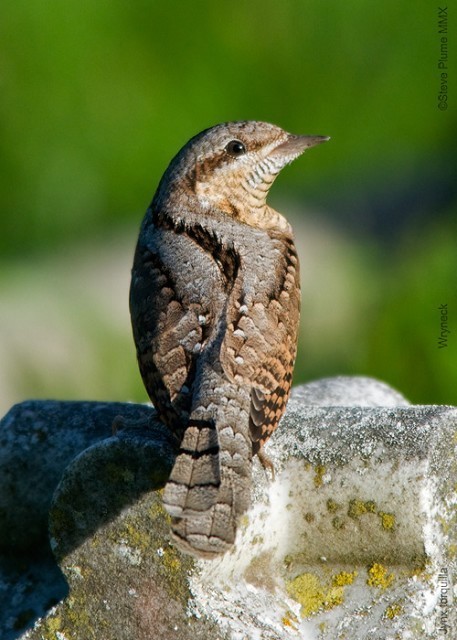
Wryneck, Southwold, Suffolk (Photo: Steve)
The Short-toed Lark remained at Fort Hommet (Guernsey) to 16th, with other one-day birds at Erris Head (Co Mayo) on 14th and on North Ronaldsay (Orkney) on 18th. Good numbers of Shore Larks arrived this week along the east coast, with up to 14 at Cley (Norfolk) and seven at nearby Happisburgh. Small groups were also in Suffolk and Kent with singles in Shetland, Cleveland, Northumberland, Lincolnshire and East Sussex. Similar winter fare was the arrival of the first flocks of Waxwings. Small numbers were seen at many east-coast localities, with the largest groups being 20 over Dunkeld (Perth & Kinross) on 20th, 15 at Norwick, Unst (Shetland) on 16th and 11 on North Ronaldsay (Orkney) on 17th.
Following 21 last week, this week saw 17 Richard's Pipits, with four in Norfolk, three in Kent, two on Scilly and singles in Highland, Orkney, North Yorkshire, Glamorgan and Guernsey. There were then two at Buckton (East Yorkshire); the only inland bird was at Burrough Hill (Leicestershire) on 18th.
Presumably the same Tawny Pipit remained on St Martin's (Scilly) to 14th and most of the other pipit action was early in the week, with Olive-backed Pipits on Unst (Shetland) on 14th–16th, Fair Isle (Shetland) on 14th and the Farne Islands (Northumberland) on 14th–15th. Similarly, there were 10 records of Red-throated Pipit, but all before 17th: in Shetland, Cleveland, Cheshire, East Yorkshire, Norfolk, London, Dorset, Cornwall, Scilly and Co Cork.

Tawny Pipit, St. Martin's, Scilly (Photo: Rik Addison)
The record year for Red-flanked Bluetails continued apace and the autumn's tally is now close to 30 birds, easily double any previous annual tally. This week, the bird remained at Waxham (Norfolk) to 14th and another was at Holme Dunes NWT in the same county on 17th. Shetland birds were at Kergord to 15th, at Boddam on same date with one on Fair Isle the next day. Others were at Lowestoft (Suffolk) on 17th–20th, St Martin's (Scilly) on 19th–20th, Lundy (Devon) on 18th and one was ringed at Mire Loch (Borders) on 16th. The first for Hampshire was at Sandy Point on 20th and, though initially in a private area, some access was eventually arranged.
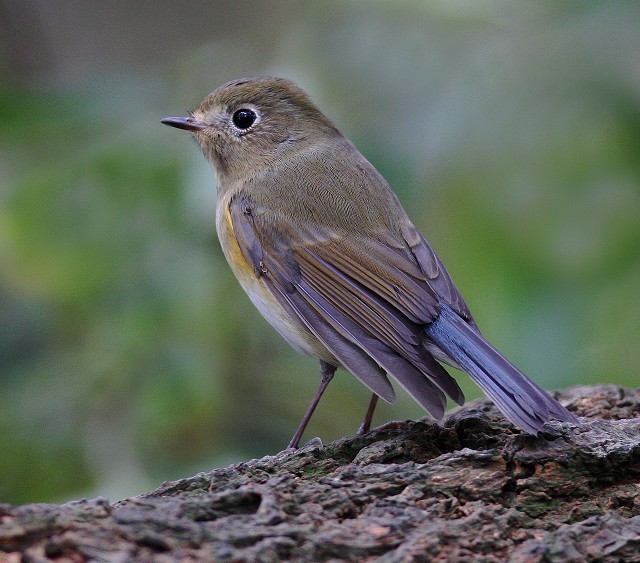
Red-flanked Bluetail, Waxham, Norfolk (Photo: Steve Wilce)
Again in contrast, there were only three Bluethroats this week, with birds on St Agnes and St Mary's (Scilly) on 15th and one at Rainham Marshes (London) on 16th. Perhaps not surprisingly all of last week's rare wheatears moved on, though it was surprising that no more arrived. Yet more Black-throated Thrushes turned up though, with a male at Kirkwall airport (Orkney) on 16th and one over the 'vis-mig' watchpoint at Sharpenhoe Clappers (Bedfordshire) on 18th.
On Scilly, the Bryher Subalpine Warbler remained to 15th and another was on St Mary's on 15th–20th. The Dartford Warbler also remained on St Agnes to 16th.

Subalpine Warbler, Bryher, Scilly (Photo: Gary Thoburn)
The long-staying Barred Warbler remained at Scarborough until 14th and at least 13 others were present across the country.

Barred Warbler, Newbiggin-by-the-Sea, Northumberland (Photo: E Barnes)
There was a late Marsh Warbler at Mewslade Bay (Glamorgan) on 14th, and the Fair Isle (Shetland) Blyth's Reed Warbler remained to 19th. Late news also came out of one photographed on a survey vessel 100 miles off Yorkshire on 12th, sent to the BirdTrack Organiser at BTO.

Blyth's Reed Warbler, at sea, East Yorkshire (Photo:
BirdGuides)
The only remained Hippos were on the Isles of Scilly, with an Icterine on Bryher and a Melodious on St Martin's to the end of the week. At the opposite end of the country, the only Western Bonelli's Warbler remained at Lerwick (Shetland) to 16th.

Melodious Warbler, St. Martin's, Scilly (Photo: John Nadin)

Western Bonelli's Warbler, Lerwick, Mainland, Shetland (Photo:
David H Hatton)
Good numbers of Yellow-browed Warblers remained and were too numerous even to count this week. Sites with two included Mire Loch (Borders), Great Yarmouth cemetery (Norfolk), Southwold (Suffolk), Nanquidno (Cornwall) and Galley Head (Co Cork) and three were recorded at Kergord (Shetland), St Abb's Head (Borders), Holkham Pines (Norfolk) and Mizen Head (Co Cork). As usual Fair Isle shone out, though, with up to seven on 16th. Several of the tit flocks holding Yellow-broweds also held Pallas's Warblers, and singles were reported from east-coast sites between Northumberland and Kent, with four in Norfolk, three in Kent and two in Suffolk. It's always surprising how few turn up further north, and to the south there were just singles at Beachy Head (East Sussex), Soar (Devon) and Nanquidno (Cornwall).

Pallas's Warbler, Warham Greens, Norfolk (Photo: Jeff Delve)
As might be expected, a few late Radde's Warblers appeared, with birds at Toab (Shetland) on 14th–15th, Gugh (Scilly) on 16th–17th and Cot Valley (Cornwall) on 20th. The only Dusky Warbler remained at Scarborough (North Yorkshire) to 17th.

Radde's Warbler, Toab, Mainland, Shetland (Photo: David H Hatton)
Fewer Red-breasted Flycatchers remained, with the three on the Isles of Scilly being most notable. Elsewhere, two were in Norfolk with singles in Shetland, East Yorkshire, Devon and Cornwall.
The widespread arrival of Great Grey Shrikes continued, with at least 41 birds in 24 counties being notable. Suffolk held five birds, with four on Shetland and three in Norfolk, Lancashire and Derbyshire. The Woodchat Shrike remained at Hartlepool Headland (Cleveland) to 17th, the Isabelline Shrike showed well at Scousburgh (Shetland) to 16th and the only remaining Red-backed Shrikes were at South Gare (Cleveland) to 14th and Rossall Point (Lancashire) to 15th.

Great Grey Shrike, Grove Ferry NNR, Kent (Photo: Mark Chidwick)
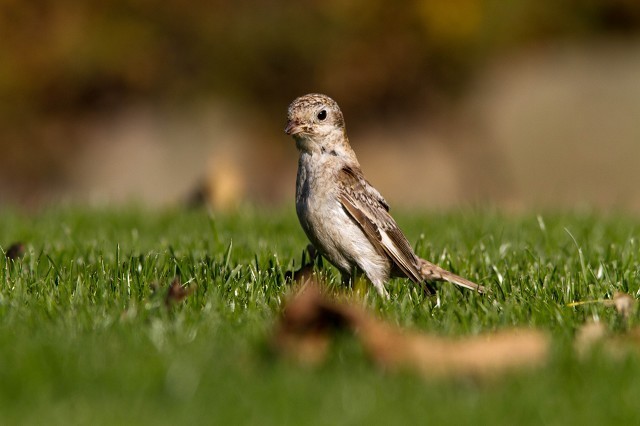
Woodchat Shrike, Hartlepool Headland, Cleveland (Photo: David Brown)
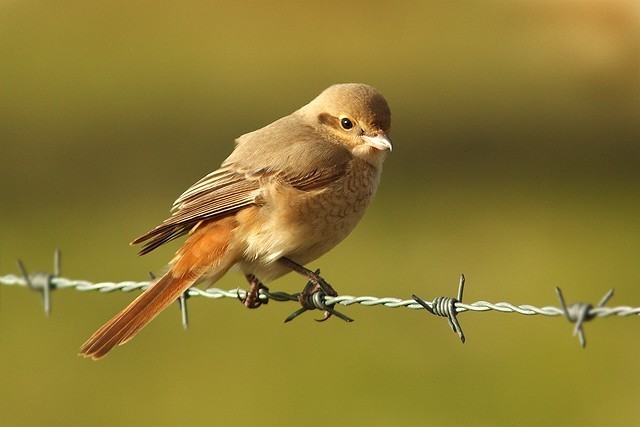
Isabelline Shrike, Scousburgh, Mainland, Shetland (Photo: David H Hatton)
The juvenile Rose-coloured Starling in Cornwall had moved from Penzance and was seen at nearby Polgigga and Sennen to 16th. Other juveniles were at St Agnes (Scilly) on 14th, Cunningsburgh (Shetland) on 14th–18th, Easington (East Yorkshire) on 16th–18th and at Lepe Country Park (Hampshire) on 20th, with the adult at Newhaven (East Sussex) to 19th.

Rose-coloured Starling, St. Agnes, Scilly (Photo: John Nadin)

Rose-coloured Starling, Newhaven, East Sussex (Photo: Peter Solly)
All the Arctic Redpolls were on Shetland, with hornemanni-race birds on Fair Isle all week and at Wester Quarff on 17th, and an exilipes, or Coue's, bird at Baltasound, Unst to 16th. There was an interesting late-autumn Serin at Pegwell Bay (Kent) on 19th. Reports of Common Rosefinches dropped dramatically, with the only birds being one still on St Martin's (Scilly) to 17th and one at Church Cove (Cornwall) on 18th–19th.
A few more Little Buntings turned up this week, with one between Morston and Stiffkey (Norfolk) on 15th, two on the Isles on Scilly, on St Martin's and St Mary's, and one on Cape Clear (Co Cork) on 20th. There were still some big flocks of Lapland Buntings being reported, with peaks of 109 on North Ronaldsay (Orkney) on 17th, 70 in Cemlyn Bay (Anglesey), 70 at Wormiston (Fife), 60 at Skaw, Unst (Shetland) and 40 at Holme next the Sea (Norfolk).
The Red-eyed Vireo remained at Firkeel Glen (Co Cork) until 19th and a popular bird was in the Parsonage, St Agnes (Scilly) on 14th–18th.

Red-eyed Vireo, St. Agnes, Scilly (Photo: Mark Pearson)
Lastly, a few unusual races caused some discussion this week. The possible Peregrine Falcon of the race calidus or tundrius was on St Mary's (Scilly) again on 14th, and a possible eastern Yellow Wagtail was on St Mary's on 14th–16th. Another possible was the Central Asian Lesser Whitethroat ringed at Buckton (East Yorkshire) on 15th, though more obvious were the two Northern Long-tailed Tits at Southwold (Suffolk) on 17th–19th.
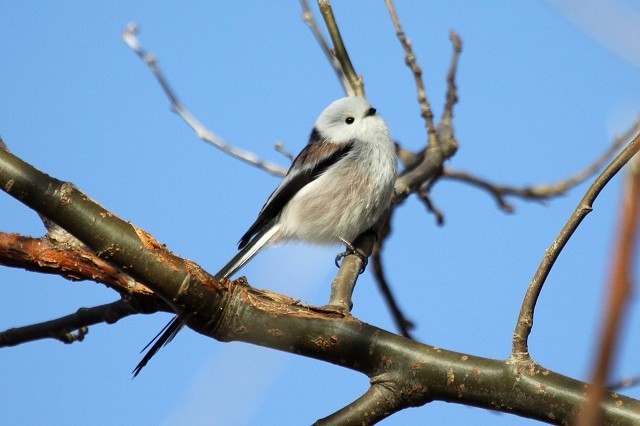
Northern Long-tailed Tit, Southwold, Suffolk (Photo: Nick Appleton)
Photo of the Week: 14th—20th October
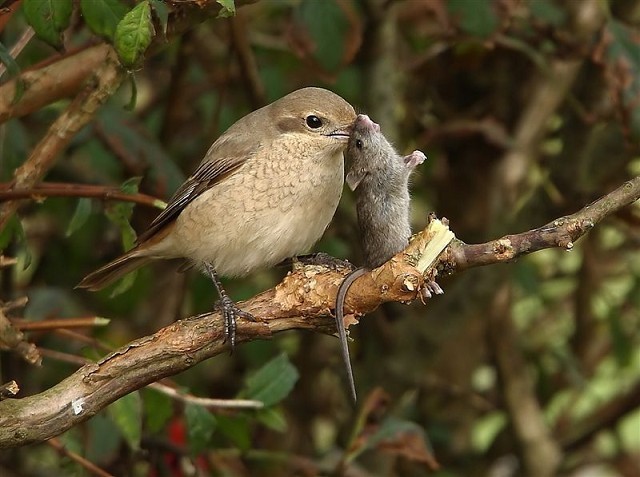
Isabelline Shrike, Scousburgh, Mainland, Shetland (Photo:
James Wood)
The Shetland islands are well known as one of the UK's best locations for rare birds and a good range of species have been photographed there by bird photographer James Wood. On his most recent trip there, James found an Isabelline Shrike, a bird barely bigger than a sparrow that certainly punches above its weight when it comes to catching prey. Feeding on small birds, rodents, lizards and large insects, the Isabelline Shrike impales its prey on thorns, in common with other members of the shrike, or butcherbird, family. In fact, this particular female has been seen with the remains of Blackcap, Twite, Robin and Brambling in its 'larders'. Our chosen photo, though, features the bird with one of several mice it had been seen to catch. James captured the action as the shrike landed on a branch, holding the head of the unfortunate mouse in its bill. Despite the rarity of the spectacle, James managed to create a superb composition that sums up the event, with bird, mouse and branch perfectly positioned in the frame. Strong eye contact with both predator and prey really draw the viewer into the image and force an emotional response.
Other notable photos
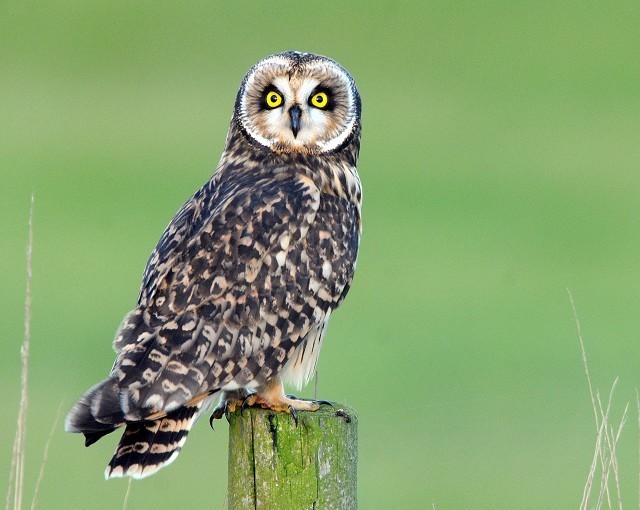
Short-eared Owl, Southwold, Suffolk (Photo:
Jon Evans)

Lilac-breasted Roller, South Africa (Photo:
Paul Hillion)

Jay, Germany (Photo:
Siegbert Werner)

Bearded Tit, undisclosed site, Essex (Photo:
Lea Roberts)

Siskin, Donna Nook, Lincolnshire (Photo:
Dean Eades)

Cuckoo, India (Photo:
Mital Patel)
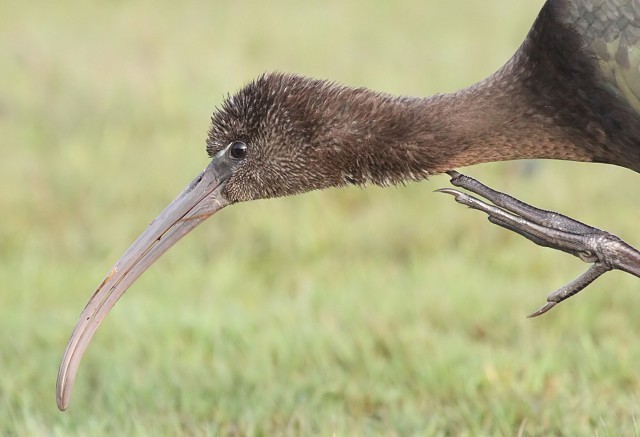
Glossy Ibis, Stanpit Marsh, Dorset (Photo:
Lee Fuller)
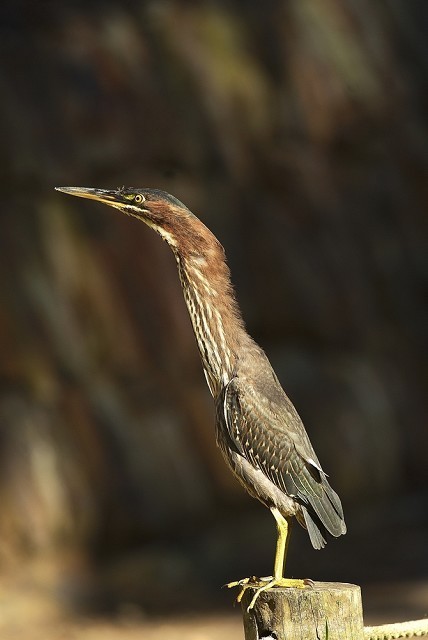
Green Heron, Heligan, Cornwall (Photo:
Bob Mitchell)

Little Egret, Widewater Lagoon, West Sussex (Photo:
Howard Kearley)

Marsh Harrier, Qatar (Photo:
John A Thompson)

Buff-bellied Pipit, Clonea, Waterford (Photo:
Ronan McLaughlin)
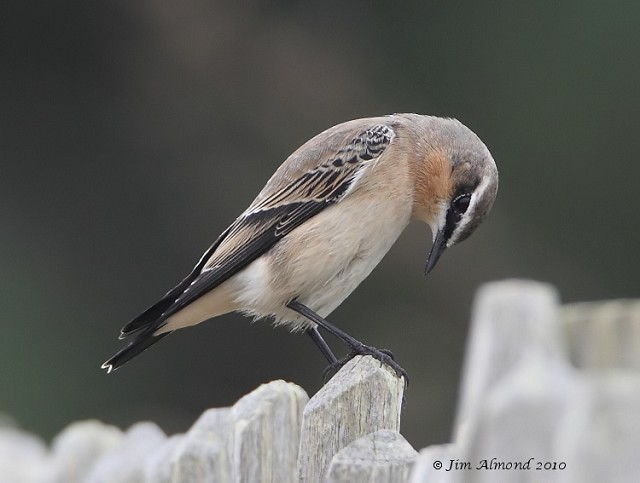
Northern Wheatear, Holkham Pines, Norfolk (Photo:
Jim Almond)

Jack Snipe, St. Mary's, Isles of Scilly (Photo:
Gary Thoburn)

Great Black-backed Gull, Burghead, Moray & Nairn (Photo:
Sandra Standbridge)
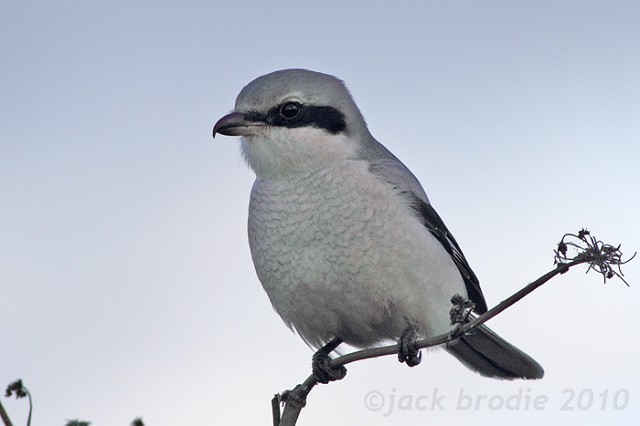
Great Grey Shrike, Cauldhall Moor, Lothian (Photo:
Jack Brodie)

Bar-tailed Godwit, St. Mary's Island, Northumberland (Photo:
Terry Cavner)

Coot, Marton Mere, Lancashire (Photo:
Cliff)
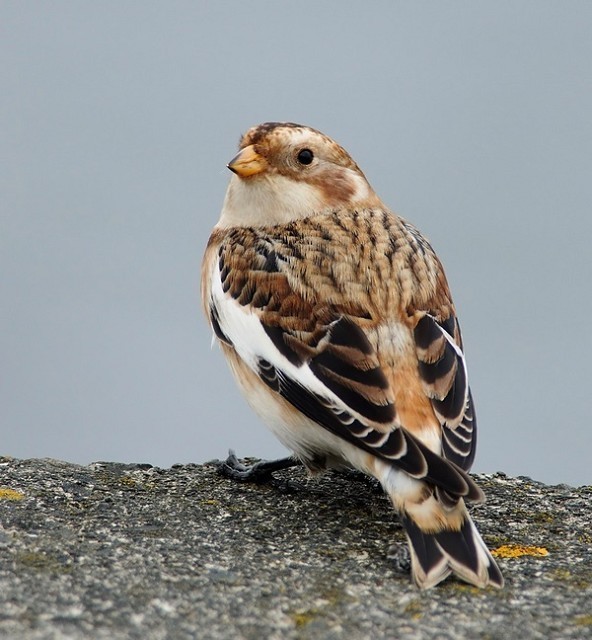
Snow Bunting, Newlyn, Cornwall (Photo:
Dave Perrett)

Sanderling, undisclosed site, Lincolnshire (Photo:
Graham Munton)

Goldcrest, Minsmere RSPB, Suffolk (Photo:
Steve)

